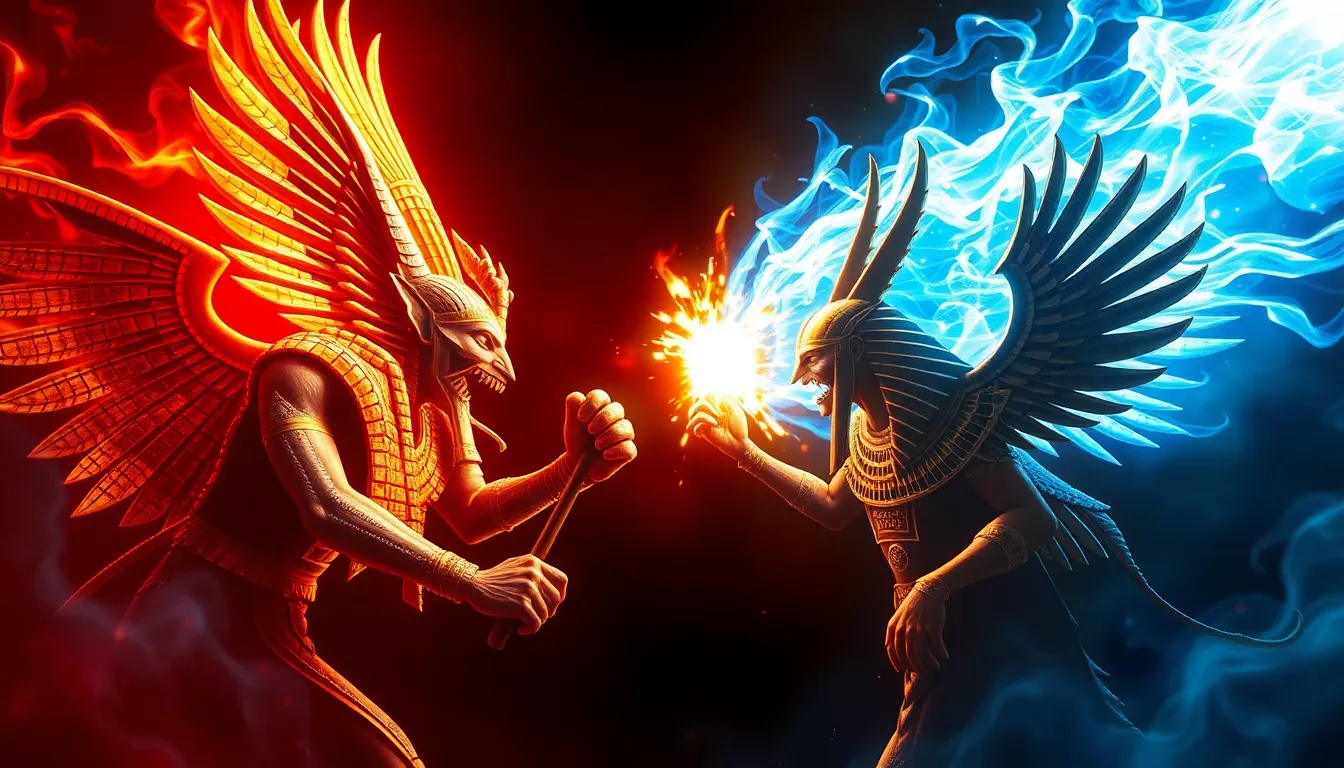The Mythical Battle Between Ra and Apep: Good vs. Evil
I. Introduction
Egyptian mythology is a vast and intricate tapestry of gods, goddesses, and mythical creatures that shaped the beliefs and practices of ancient Egyptians. Among these deities, Ra, the sun god, stands as a symbol of light, creation, and order. In stark contrast, Apep, also known as Apophis, represents chaos, darkness, and destruction. The relentless battle between Ra and Apep is not merely a conflict between two figures; it embodies the eternal struggle between good and evil that resonates throughout human history. This mythological confrontation was of paramount importance in ancient Egyptian culture, symbolizing the daily triumph of light over darkness, and reflecting the Egyptians’ understanding of life, death, and the cosmos.
II. The Origins of Ra: The Sun God
Ra is one of the most significant and revered deities in the Egyptian pantheon. Often depicted as a falcon-headed man crowned with a solar disk, his very essence is intertwined with the sun itself. Ra’s significance can be summarized in the following points:
- Creator God: Ra was believed to be a creator god, responsible for bringing life and light to the world.
- Symbol of Authority: As the sun god, Ra represented the ultimate authority and power, ruling over all other gods.
- Daily Cycle: Ra’s journey across the sky each day symbolized the cycle of life, death, and rebirth.
Ra’s attributes include warmth, growth, and illumination, making him a vital figure in agriculture and daily life. His daily journey across the heavens and his nightly descent into the underworld symbolize the cyclical nature of existence, where death leads to rebirth.
III. The Nature of Apep: The Serpent of Chaos
Apep, in stark contrast to Ra, is depicted as a giant serpent or dragon-like creature. This malevolent entity embodies chaos and darkness, and his characteristics can be described as follows:
- Symbol of Destruction: Apep represents the forces of chaos that threaten the order established by Ra.
- Embodiment of Fear: Apep is often associated with nightmares and the fears of the unknown that lurk in the dark.
- Serpentine Symbolism: Serpents in ancient cultures are often seen as symbols of evil and danger, reflecting Apep’s role as an adversary to the gods.
Apep’s continuous attempts to consume Ra during his nightly journey through the underworld reflect the deep-seated fears of chaos that permeated ancient Egyptian society.
IV. The Cosmic Battle: Ra vs. Apep
The epic battle between Ra and Apep takes place during Ra’s nightly journey through the underworld, known as Duat. As Ra travels through this dark realm, he encounters Apep, who lies in wait to bring about the sun god’s demise. This confrontation unfolds in several stages:
- Ra’s Journey: Every night, as Ra descends into the underworld, he travels through various realms, facing numerous challenges.
- Confrontation with Apep: Apep attempts to ambush Ra, creating chaos and darkness in his path.
- Mythical Narratives: Various myths describe Ra’s battles against Apep, illustrating the struggle between order and chaos.
These narratives often depict Ra overcoming Apep through the assistance of other deities, symbolizing the collective effort against darkness.
V. The Role of Other Deities
In the eternal struggle against Apep, Ra is not alone. Other deities play crucial roles in assisting the sun god in his battle against chaos. Key allies include:
- Set: The god of chaos himself, Set is often portrayed as a protector of Ra, battling Apep to maintain order.
- Horus: The falcon-headed god, representing justice and order, aids Ra in his cosmic battles.
- Ma’at: The goddess of truth and order, Ma’at symbolizes the balance that Ra strives to maintain against Apep’s chaos.
The involvement of these deities highlights the significance of divine support in the ongoing battle between good and evil, emphasizing that the fight for order requires unity among the gods.
VI. Symbolism and Themes in the Myth
The battle between Ra and Apep serves as a rich metaphor for the struggle between light and darkness, encapsulating several themes:
- Light vs. Darkness: Ra symbolizes light, knowledge, and order, while Apep embodies darkness, ignorance, and chaos.
- Life, Death, and Rebirth: The cyclical nature of Ra’s journey illustrates the concept of death leading to rebirth, as the sun rises again each day.
- Moral Lessons: The myth teaches the importance of courage in the face of fear, and the need for cooperation to overcome evil.
These themes reflect the ancient Egyptians’ worldview, emphasizing that life is a continuous battle against chaos that requires vigilance and unity.
VII. Cultural Impact and Legacy
The myth of Ra and Apep deeply influenced ancient Egyptian society and religion. It affected various aspects of their culture, including:
- Religious Practices: Rituals were performed to honor Ra and to protect against Apep’s chaotic influence.
- Artistic Representations: Ra and Apep were frequently depicted in tomb paintings, sculptures, and amulets, showcasing their importance in the afterlife.
- Modern Interpretations: The themes of the myth continue to resonate in modern literature, film, and art, serving as a universal symbol of the battle between good and evil.
These cultural legacies illustrate the enduring power of myth in shaping human understanding and morality.
VIII. Conclusion
The battle between Ra and Apep stands as a powerful allegory for the eternal struggle between good and evil. It encapsulates the fears and hopes of ancient Egyptians, reflecting their understanding of the universe and the moral lessons derived from their myths. The enduring nature of this conflict continues to resonate through time, reminding us of the complexities of morality and the importance of striving for order amidst chaos. As we explore these ancient narratives, we gain insights into the human condition, reminding us that the battle between light and darkness is a timeless theme that transcends cultures and epochs.




